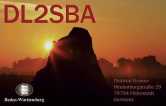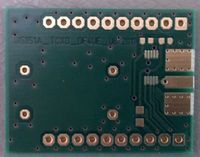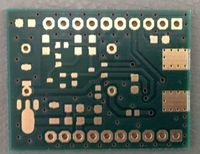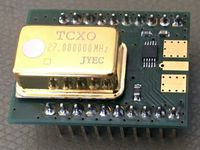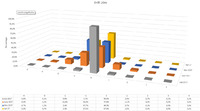I've build the original QRP-labs U3S from stock. Means the supplied crystal on the PLL-based synthesiser-board.
This configuration is basically working up to 20m with a lot amount of drift, but you will get many decodes on wsprnet.org. On 6m you can also get spots - once a day :-/
First I've made the improvements suggested by QRP-Labs. But this also didn't improve the decode rate significantly. Due to desperation I have soldered a FOX-TCXO on the PCB, even it is known, that this TCXO makes frequent frequency "jump" within some Hz. As expected, the result didn't improve too.
During all these experiments, I've stayed in touch with Hans, DF4UE. He was watching my WDPR signal on 6m and pointed me to the huge amount of drift.
After some discussions, Hans DF4UE offered me an optional PLL-based synthesiser board designed by himself:
This board provides a place for a cheap chinese TCXO. This TCXO comes pre-calibrated to 27.000.001Hz and shows on a breadboard a very low temperature coefficient.
This board replaces the original PLL-based synthesiser board from QRP-Labs and fits well into the U3S stack:  .
.
Populated the board looks like this:
The DF4UE-Board is now up and running in my U3s since July 1st - check the drift:
- In April and May I'm using the regular crystal on the original synthesiser-board.
- In June I'm using a FOX TCXO on the original synthesiser-board.
- In July I've switched to the DF4UE-Board - what an enlightenment :-)
Now the GPS board is only for time synchronisation - no longer any frequency correction necessary - Thanks Hans DF4UE for this great solution and the support you've provided to me!
PS: Hans G0UPL pointed me to the difference between a DDS-based synthesizer and a PLL-based synthesiser. The U3S board is a PLL-based synthesiser - thanks.
